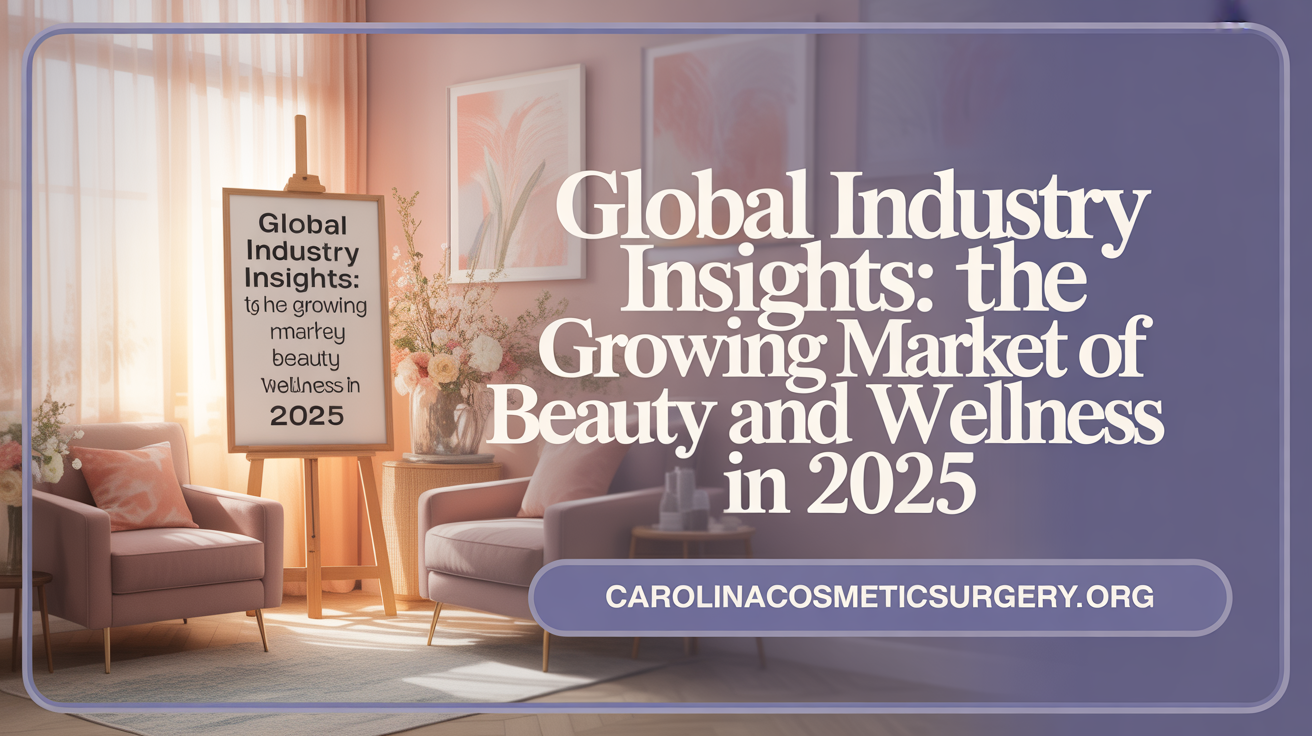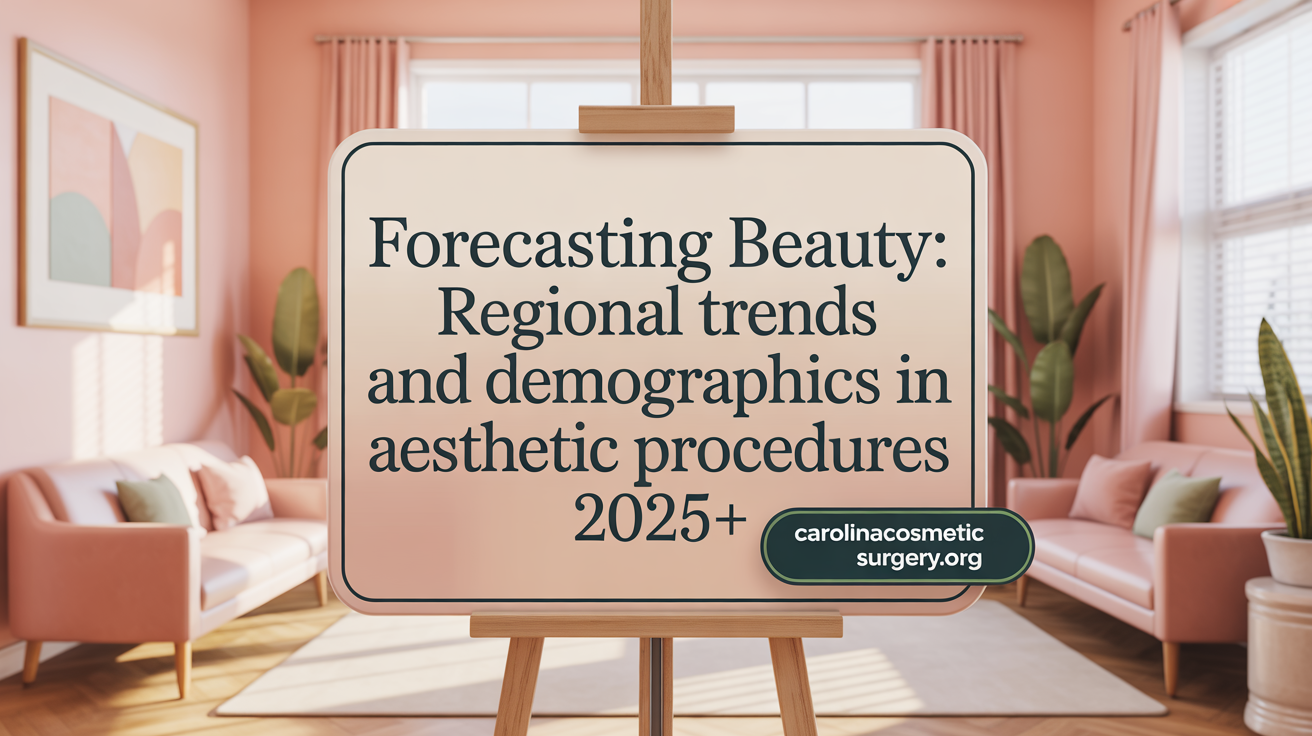Introduction to Regional Cosmetic Surgery Trends in 2025
As cosmetic surgery continues to evolve through technological innovations and shifting consumer preferences, understanding the regional dynamics shaping the industry in 2025 has never been more critical. This analysis offers a comprehensive state-by-state overview of cosmetic surgery trends across the United States, intersected with global insights to provide perspective on growth, demand, and demographic influences. From procedure popularity and surgeon distribution to economic drivers and market forecasts, we explore the complex layers that define where and why cosmetic surgeries are flourishing regionally.
Global Cosmetic Surgery Trends Shaping Regional Markets
What are the projected global trends and statistics for cosmetic surgery in 2025?
By 2025, the landscape of cosmetic surgery is anticipated to undergo notable changes, driven by technological innovations and shifting consumer preferences. The global market is expected to favor less invasive procedures, such as nonsurgical skin tightening and injectable treatments, alongside traditional surgeries.
Procedures like liposuction and tummy tucks continue to see rising popularity, with annual growth rates of approximately 7% and 5%, respectively. Liposuction remains a leading choice for body contouring due to its effectiveness and minimally invasive nature.
Eyebrow and eyelid lifts are also expected to gain more traction, especially among men seeking subtle enhancements. Meanwhile, a trend towards natural results has influenced the popularity of smaller breast implants and autologous fat grafting, which involves using the patient's own tissue for a more organic look.
A significant shift is observed among younger generations, particularly Gen Z and millennials, who are more inclined towards preventive and maintenance procedures. Popular choices include rhinoplasty and cheek implants to preserve a youthful appearance and counteract aging signs early.
Interestingly, the 'menopause makeover' trend is emerging, targeting women in their 40s and 50s with procedures designed to rejuvenate and restore confidence, emphasizing personalized aesthetic solutions.
In essence, 2025's global cosmetic surgery scene is characterized by technological enhancements, evolving beauty standards, and a preference for natural-looking, minimally invasive options among diverse age groups worldwide.
Worldwide Leaders in Cosmetic Surgery Rates: Context for U.S. Regional Analysis
Which countries have the highest rates of plastic surgery, and how do these rates compare globally?
South Korea stands out as the country with the highest per capita rate of plastic surgery. In 2021, approximately 8.90 procedures were performed for every 1,000 people, establishing South Korea as a global leader in cosmetic surgery prevalence.
Following closely are Argentina and Brazil, with rates of 8.81 and 7.62 procedures per 1,000 residents, respectively. These figures reflect a strong cultural emphasis on aesthetic enhancement within Latin America.
Other nations with notable rates include Colombia and Greece, both performing over 7 procedures per 1,000 inhabitants. Despite the high procedure volume, the United States leads in the total number of surgeries, with over 7.4 million performed in 2021. However, its per capita rate is lower at approximately 5.91 procedures per 1,000 people, indicating that the high total volume is partly due to its large population.
Globally, a pattern emerges showing that many Asian and Latin American countries maintain higher per capita plastic surgery rates compared to Western nations. The upward trend in these procedures worldwide suggests growing acceptance and cultural normalization of cosmetic enhancements. Countries like South Korea, Argentina, and Brazil exemplify regional trends driven by social, cultural, and media influences that prioritize aesthetic appearance.
In the context of global growth, it is expected that plastic surgery will continue to rise in popularity by 2025. The registration of these trends reveals how regional attitudes, economic factors, and cultural values shape the landscape of cosmetic procedures across the globe.
Comparative Overview of Global and U.S. Procedure Volumes
| Country/Region | Procedures per 1,000 People | Total Procedures (2021) | Notes |
|---|---|---|---|
| South Korea | 8.90 | N/A | Leader in per capita rates |
| Argentina | 8.81 | N/A | Latin America's top performer |
| Brazil | 7.62 | N/A | High regional demand |
| Colombia | >7 | N/A | Notable Latin American rates |
| Greece | >7 | N/A | European country with high rate |
| United States | 5.91 | 7.4 million | Highest total number of procedures |
Cultural and Regional Influences on Surgery Prevalence
Cultural attitudes toward beauty significantly influence regional surgery rates. In South Korea, societal pressure for perfection and beauty standards drive high demand. Latin American countries like Argentina and Brazil also emphasize appearance, contributing to their high procedure rates.
In Western countries like the U.S., although the total number of surgeries is massive, the per capita rate is lower, reflecting a diverse range of cultural attitudes toward cosmetic procedures. Overall, these regional differences highlight how social norms, cultural ideals, and economic factors shape the global landscape of cosmetic surgery.
State-by-State Cosmetic Surgery Rates and Distribution in the U.S.

How do cosmetic surgery rates vary across different states?
The distribution of cosmetic procedures across the United States shows notable differences from state to state. According to the 2024 Plastic Surgery Statistics from the American Society of Plastic Surgeons, some regions have higher participation in cosmetic surgeries, while others report lower rates.
While specific figures for each state are not detailed here, the overall data highlights regional preferences with Southern and Western states generally showing higher rates of procedures like liposuction, breast augmentations, and facelifts. Conversely, some Northeastern states report lower frequencies, potentially due to demographic differences or economic factors.
What regional influences impact the frequency of cosmetic surgeries?
Regional culture and societal norms heavily influence cosmetic surgery trends. For example, states with a higher disposable income or more urban centers tend to have greater demand.
Availability of qualified surgeons also plays a role. States with a higher density of certified plastic surgeons often see increased procedures. Moreover, states where beauty standards emphasize youthful appearance or body image tend to report elevated surgery rates.
How does the economic landscape affect accessibility and costs?
Economic considerations are crucial in shaping the landscape of cosmetic surgery. Higher average surgeon fees are typically found in states with more affluent populations, impacting who can afford these procedures.
In states where the cost of living is lower, the affordability of cosmetic surgeries usually increases accessibility for broader populations. This economic disparity influences not only the number of surgeries performed but also the geographical distribution of qualified surgeons.
| Region | Typical Surgery Rate | Average Surgeon Fee | Economic Impact on Accessibility |
|---|---|---|---|
| South & West | Higher | Moderate to High | Greater demand due to wealth and urban centers |
| Northeast | Lower | Higher | Cost sensitivity may limit accessibility |
| Midwest | Moderate | Moderate | Balanced demand influenced by population size |
By understanding these regional patterns, future trends can be better predicted, and efforts to improve access can be tailored for specific areas.
Demographic and Economic Drivers Influencing Regional Surgery Trends
What demographic and economic factors influence regional variations in cosmetic surgery trends?
Regional differences in cosmetic surgery trends are shaped by a complex mix of demographic and economic influences. Demographics like age, gender, race, and cultural background play a significant role in determining what procedures are popular in different areas.
Younger populations and higher-income groups tend to be more interested in cosmetic procedures. Urban centers, often with wealthier residents, typically show higher participation rates. For example, cities with diverse populations may see a variety of preferences, from facial refinements common in the West to body-enhancement procedures in the South.
Cultural norms and attitudes towards beauty significantly steer the types of surgeries popular in each region. In some places, fuller body contours are highly desired, while in others, facial aesthetics take precedence.
Economic prosperity is closely linked to the demand for cosmetic surgeries. Wealthier regions tend to have more access to advanced medical services and more disposable income, making individuals more likely to pursue aesthetic changes. Rising income levels in a region often lead to a surge in elective procedures.
Demographic shifts, such as increasing cultural diversity and population aging, also influence the trends. Younger demographics are more open to novelty and social influences, while an aging population may seek procedures to maintain a youthful appearance.
In summary, regional variations in cosmetic surgery are driven by a blend of demographic factors—age, race, gender, cultural norms—and economic conditions. The interaction of these elements continues to evolve, reflecting broader societal changes.
| Region | Predominant Factors | Common Procedures | Cultural Influences |
|---|---|---|---|
| West | Younger populations, high income, diversity | Facial refinement, Botox | Emphasis on natural beauty |
| South | Higher obesity rates, body-focused culture | Body contouring, liposuction | Preference for fuller figures |
| Northeast | Aging population, wealth concentration | Anti-aging treatments, facelifts | Aesthetic preservation |
| Midwest | Moderate income, suburban areas | Breast surgery, skin treatments | Practical beauty standards |
Understanding these socio-economic and demographic trends helps clinics and practitioners tailor their services to regional preferences, ensuring they meet the specific desires and needs of their communities.
Surgeon Distribution and Procedure Popularity: Regional Disparities Explained

How do regional differences manifest in surgeon distribution and types of cosmetic surgery performed?
Regional disparities significantly influence where surgeons are located and what procedures are most common in different areas. Data from the American Society of Plastic Surgeons demonstrates that some regions have a higher density of cosmetic surgeons than others, often due to population size, economic factors, and local demand.
In high-density regions, patients typically have more options for choosing a surgeon, which can lead to a higher volume of procedures. Conversely, areas with fewer specialists may see longer wait times and limited choices for patients.
Certain procedures tend to be more popular depending on regional preferences and cultural influences. For example, rhinoplasty and liposuction are frequently performed in areas where there is a strong cultural emphasis on facial aesthetics and body contouring.
The ISAPS Global Survey 2023 highlights that these trends are not uniform worldwide. In some regions, non-invasive treatments like Botox and fillers are more in demand, while others favor surgical options.
Most common procedures by geographic area and their relation to surgeon availability
| Region | Most Common Procedures | Approximate Procedure Volume | Notes |
|---|---|---|---|
| North America | Liposuction, breast augmentation | High | Greater surgeon availability drives higher procedure volume |
| Europe | Rhinoplasty, eyelid surgery | Moderate | Cultural preferences influence common surgeries |
| Asia | Double eyelid surgery, facial contouring | Growing | Increased number of specialists expands options |
| Middle East | Non-invasive treatments, body contouring | Increasing | Access is expanding with new clinics |
Relationship between surgeon availability and procedure volume
The number of surgeons in a region directly impacts the volume of cosmetic procedures performed. More surgeons typically mean higher competition and accessibility, leading to more procedures overall. Conversely, regions with fewer specialists may see lower volumes due to limited access.
This correlation underscores the importance of geographic distribution in shaping the cosmetic surgery landscape. As more surgeons practice in underserved areas, it is expected that access and procedure choices will expand accordingly.
| Aspect | Effect | Explanation |
|---|---|---|
| Surgeon Density | Higher density | More procedures are performed due to greater access |
| Regional demand | Varies | Cultural and aesthetic preferences influence popular surgeries |
| Procedure Choices | Region-specific | Local trends and surgeon expertise guide procedure popularity |
Understanding these regional differences helps providers anticipate demand patterns and improve patient access to diverse cosmetic options.
Regional Patient Interest and Search Behavior in Cosmetic Surgery
How does patient interest and search behavior vary regionally for different cosmetic surgery procedures?
Patient interest in cosmetic surgery significantly varies across different regions of the United States. These differences are mainly driven by cultural, ethnic, and demographic factors, shaping what procedures are most popular in each area.
For instance, in 2023, the Northeast saw a higher interest in breast augmentation, reflecting regional aesthetic preferences. Moving to the Midwest, liposuction, breast lifts, and facelifts were the most searched procedures, indicating a focus on body contouring and facial rejuvenation.
In the South, procedures like Brazilian Butt Lifts and tummy tucks gained popularity, showing regional beauty standards that emphasize curvier body shapes. Meanwhile, the West tends to favor rhinoplasty, breast augmentation, and liposuction, highlighting different regional priorities.
These variations reveal how local culture and demographics influence patient preferences. Patients tend to search for procedures that align with their regional aesthetic ideals and cultural backgrounds, making regional search patterns a useful indicator for clinics and practitioners to tailor their services.
Which procedures are most popular in different U.S. areas?
| Region | Popular Procedures | Additional Insights |
|---|---|---|
| Northeast | Breast augmentation | Higher interest in traditional breast procedures |
| Midwest | Liposuction, breast lift, facelifts | Focus on body and facial rejuvenation |
| South | Brazilian Butt Lifts, Tummy Tucks | Preference for curvy body enhancements |
| West | Rhinoplasty, breast augmentation, liposuction | Emphasis on facial reshaping and body contouring |
Understanding these regional trends can help cosmetic surgeons target the right procedures for their local markets.
How do cultural and demographic factors influence patient interests?
Cultural attitudes towards beauty and body image heavily influence search behavior. Ethnic backgrounds also impact preferences, with certain procedures being more popular among specific demographic groups. For example, regions with diverse populations may see increased interest in procedures that enhance features traditionally valued within those communities.
Demographic factors such as age, income level, and cultural identity play roles as well. Younger populations may favor procedures like rhinoplasty or lip enhancement, while older patients could be more interested in facelifts or eyelid surgeries.
In summary, local cultural norms and demographics shape the cosmetic surgery landscape, making regional search data a vital tool for industry professionals seeking to understand and meet patient needs across varying communities.
Economic Landscape and Market Size of the Cosmetic Surgery Industry in 2025

What are the current market size, growth rates, and regional demand outlooks for cosmetic surgery?
The global cosmetic surgery market was valued at approximately $80.07 billion in 2024 and is expected to reach around $85.83 billion by 2025. This steady expansion is part of a broader trend that will see the market almost double in size over the next decade, reaching an estimated $160.47 billion by 2034. The compound annual growth rate (CAGR) from 2025 to 2034 is projected at about 7.20%, reflecting robust industry health.
North America leads the industry, with the United States making up a significant share—around 36-42% of global demand. In 2025, the US market alone is valued at roughly $21.63 billion. It is expected to grow at a CAGR of 5.4%, reaching approximately $36.35 billion by 2034. This region's demand is driven by an aging population, increasing awareness of cosmetic options, and technological innovations that make procedures more accessible and effective.
Europe and Asia-Pacific are also experiencing rapid growth. Europe benefits from high consumer awareness and a growing preference for minimally invasive procedures, while Asia-Pacific is seeing increased adoption of cosmetic surgeries due to rising middle-class incomes and shifting beauty standards.
Overall, the industry's outlook indicates rising interest in both surgical and non-surgical procedures. Younger demographics and men are contributing to demand, further accelerating market expansion. Technological advances, such as laser treatments, robotic-assisted surgeries, and improved safety protocols, have played a vital role in making cosmetic procedures more appealing and accessible worldwide.
How might technological innovation influence future market expansion?
Technological progress is central to the growth trajectory of the cosmetic surgery industry. Innovations in minimally invasive techniques, such as laser liposuction and non-surgical skin tightening, attract a broader consumer base seeking less downtime and lower risks. Enhanced imaging software and AI-driven customization allow for more precise results, increasing patient confidence.
Furthermore, advancements in recovery technology and pain management, alongside safer anesthesia practices, bolster the industry's expansion. These improvements reduce fears and barriers associated with cosmetic procedures, encouraging more frequent and diverse participation.
The ongoing development of new devices and techniques continues to drive market growth, making procedures more effective, safer, and affordable. As technology continues to evolve, it is poised to sustain the positive growth forecasts for the industry through 2034.
Market Overview Table
| Region | Market Size 2024 (USD Billion) | Projected 2025 (USD Billion) | CAGR (2025-2034) | Main Growth Drivers |
|---|---|---|---|---|
| North America | 78.00 | 85.83 | 5.4% | Aging population, technological innovation |
| Europe | 20.00 | N/A | N/A | Consumer awareness, minimally invasive procedures |
| Asia-Pacific | 15.00 | N/A | N/A | Rising middle-class incomes, shifting beauty standards |
| Rest of World | N/A | N/A | N/A | Increasing global demand |
This overview highlights the global spread and regional contributions to the industry, emphasizing sustained growth fueled by technological advances and changing consumer preferences.
Emerging Trends in Minimally Invasive and Preventive Procedures Across Regions

Rise of Less Invasive Surgeries
In recent years, there has been a notable shift towards minimally invasive surgical procedures. These approaches use smaller incisions, less anesthesia, and shorter recovery times, making elective surgeries more accessible and less daunting for patients. Procedures like laser skin resurfacing, Botox, dermal fillers, and non-surgical fat reduction are increasingly popular worldwide, offering effective results with minimal downtime.
Popularity of Preventive Cosmetic Procedures Among Younger Demographics
Another significant trend is the growing interest in preventative cosmetic treatments among younger age groups. Millennials and Generation Z are opting for procedures early on, aiming to maintain a youthful appearance and prevent future skin aging. This shift reflects a broader cultural change where cosmetic care is integrated into routine health and wellness practices.
Technological Contributions Enabling These Trends
Advancements in technology play a crucial role in these healthcare developments. Innovations such as laser technologies, radiofrequency devices, and micro-needling tools have enhanced the safety, effectiveness, and comfort of procedures. Improved imaging and diagnostic tools also allow for more personalized treatment plans, increasing patient confidence and satisfaction.
| Region | Popular Procedures | Contributing Technologies |
|---|---|---|
| North America | Botox, fillers, laser skin tightening | Laser technology, radiofrequency devices |
| Europe | Minimally invasive liposuction, skin rejuvenation | Micro-needling, ultrasound devices |
| Asia | Double eyelid procedures, non-surgical nose jobs | Advanced imaging, precision applicators |
| Latin America | Chemical peels, non-invasive fat reduction | New chemical formulations, cooling devices |
This growing trend toward minimally invasive and preventive procedures would likely continue expanding into 2025, driven by technological breakthroughs and changing patient preferences for safer, quicker, and more natural-looking outcomes.
Cultural and Regional Aesthetic Preferences Influencing Procedure Demand
Why Do Regional Preferences Matter in Cosmetic Surgery?
Different regions around the world have distinct beauty ideals that influence the popularity of certain cosmetic procedures. These cultural norms shape what individuals seek when they choose to undergo cosmetic enhancements.
Southern Preference for Fuller Body Procedures
In many Southern regions, a fuller body aesthetic is highly appreciated. Procedures such as fuller body contouring, buttock augmentations, and liposuction are in higher demand. This preference stems from cultural ideals that associate a curvier physique with health and attractiveness. Patients in these areas often seek enhancements that accentuate curves and provide a more voluptuous silhouette.
Western Focus on Facial Refinement
Conversely, Western countries tend to prioritize facial aesthetics. Young adults and older individuals alike may opt for rhinoplasty, facelift, or eyelid surgery to achieve a more refined and balanced facial appearance. This focus on facial features reflects cultural standards that emphasize well-defined cheekbones, a slim nose, and smooth skin as signs of beauty.
Integration of Cultural Norms into Cosmetic Surgery Choices
Cultural and regional norms significantly influence the types of procedures people choose. Surgeons often tailor their offerings to match these local preferences. For example, in regions where fuller bodies are preferred, providers might focus more on body sculpting procedures. In contrast, clinics in areas with a focus on facial aesthetics might promote anti-aging treatments or facial contouring.
The Future of Aesthetic Preferences
As global connectivity increases, cultural boundaries continue to blend, leading to more diverse aesthetic ideals. Nonetheless, understanding regional preferences remains crucial for practitioners aiming to meet the specific desires of their patient populations.
| Region | Popular Procedures | Cultural Focus | Additional Details |
|---|---|---|---|
| Southern US | Buttock augmentation, liposuction | Fuller bodies and curves | Reflects cultural ideals of health and vitality |
| Western Europe & North America | Rhinoplasty, facelifts | Facial refinement and balance | Emphasizes facial symmetry and youthfulness |
| East Asia | Eyelid surgery, skin treatments | Youthful appearance and skin clarity | Focused on maintaining youthful, bright looks |
Understanding these preferences helps cosmetic surgeons better serve their patients and anticipate future trends, especially as demands may evolve with changing cultural influences.
Future Forecast: Regional Industry Developments and Patient Demographics in 2025 and Beyond

How are regional growth patterns expected to evolve?
The cosmetic surgery industry is projected to experience distinct regional growth trends through 2025 and beyond. Urban areas and economically developed regions are likely to see continued expansion due to higher disposable incomes and increased access to advanced medical facilities. Emerging markets in Asia, Latin America, and Eastern Europe are expected to see rapid growth driven by rising awareness and acceptance of cosmetic procedures.
In contrast, some regions with slower economic development may face modest growth or stabilization. Overall, global expansion is anticipated to be uneven, with major metropolitan centers remaining at the forefront of industry progress.
What shifts in patient age and gender are anticipated?
Traditionally, cosmetic surgery has been more popular among middle-aged women. However, trends show a shift towards younger demographics and increased male participation.
By 2025, we expect to see a rise in procedures among Millennials and Generation Z, spurred by social media influence and changing beauty standards. Men are also predicted to constitute a larger share of patients, seeking procedures like liposuction, Botox, and facial treatments.
This demographic shift reflects broader acceptance and destigmatization of cosmetic procedures across all ages and genders, diversifying the patient base.
What technological innovations will influence regional practices?
Technological advances are set to significantly impact regional practices. Innovations like non-invasive procedures, laser-based treatments, and AI-driven diagnostics will become more prevalent.
Regions that adopt these technologies rapidly will likely attract more patients seeking less invasive options with quicker recovery times. Telemedicine consultations and virtual reality previews of procedures will also enhance patient engagement and decision-making.
Furthermore, personalized treatment plans enabled by AI and data analytics will tailor procedures to individual needs more precisely, improving outcomes.
How might surgeon distribution and procedure popularity change?
The distribution of surgeons is expected to shift as more practitioners acquire advanced training in minimally invasive techniques and digital technologies. High-demand urban centers will continue to see dense concentrations of qualified surgeons.
Globally, cosmetic surgery procedures such as eyelid lifts, nose reshaping, and body contouring are projected to gain popularity, driven by both aesthetic trends and technological improvements.
Emerging markets and regions with growing middle classes may see increased numbers of trained surgeons, democratizing access to premium cosmetic care. Overall, a convergence of technological, demographic, and economic factors will shape the evolving landscape of regional cosmetic surgery practices over the coming years.
Conclusion: Mapping the Regional Landscape of Cosmetic Surgery in 2025
The year 2025 promises continued growth, diversification, and regional differentiation in the cosmetic surgery landscape. State-by-state variations in procedure popularity, surgeon availability, and economic factors underscore the importance of localized data for industry stakeholders and patients alike. Fueled by technological innovation and evolving demographic profiles, cosmetic surgery is adapting uniquely across U.S. regions — reflecting cultural preferences and economic realities. Staying informed of these detailed regional trends empowers consumers and providers to navigate an increasingly complex and expanding market with confidence and clarity.
References
- 2025 Plastic Surgery Trends | Nextech
- Plastic Surgery Statistics - American Society of Plastic Surgeons
- Regional Beauty: The Top Plastic Surgery Procedures Across the ...
- [PDF] 2023 Plastic Surgery Statistics Report
- [PDF] 2022 Plastic Surgery Statistics Report
- Demographic and Cultural Differences in the Acceptance and ...
- Regional Beauty: The Top Plastic Surgery Procedures Across the ...
